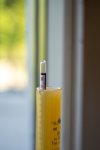Enda noen spørsmål... jeg reiser bort fra på jobb og er hjemme igjen om ca 12 dager. Drar så på jobb igjen 3 dager senere og blir borte ca 4 uker. Totalt blir det da ca 6 uker siden jeg satte dem med gjær.
Går det an at det står for lenge med gjær før det tappes på flasker? Og vis det kan det være at det ikke sukkeret jeg tilsetter flakene blir til kullsyre?
Når det skal tappes på flasker prøver vel man å unngå å få med gjæren som ligger i bunn fra gjæringskaret, eller må det være med i flasken for å bryte ned sukkeret og få kullsyre?
Går det an at det står for lenge med gjær før det tappes på flasker? Og vis det kan det være at det ikke sukkeret jeg tilsetter flakene blir til kullsyre?
Når det skal tappes på flasker prøver vel man å unngå å få med gjæren som ligger i bunn fra gjæringskaret, eller må det være med i flasken for å bryte ned sukkeret og få kullsyre?
Sist redigert:



